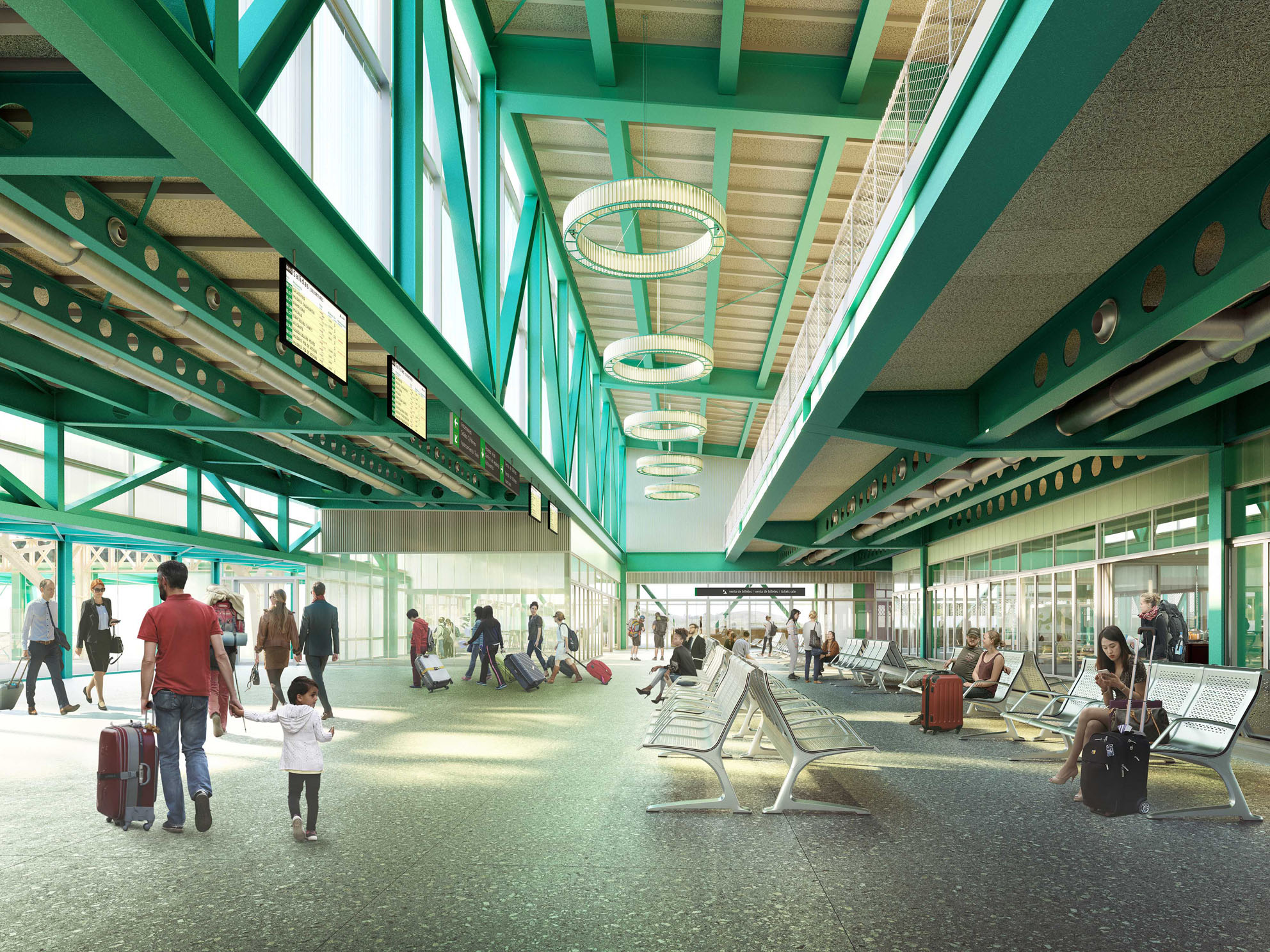New High-Speed Train Station, Pedestrian Walkway and Clara Campoamor Square
International Competition by CV Selection. First Prize (estudioHerreros + R&AS)
CLIENT: ADIF. Xunta de Galicia
PROJECT ARCHITECTS: estudioHerreros (Juan Herreros – Jens Richter)
Competition: estudioHerreros with the collaboration of R&AS
Concept Design: estudioHerreros and INECO with the collaboration of R&AS
Schematic Design and Construction Documents: Architecture: estudioHerreros; Engineering: Prointec; Structure: BACBCG
ARCHITECTURE PROJECT DIRECTORS (estudioHerreros): Abraham Piñate (Schematic Design and Construction Documents), Víctor Lacima (Concept Design)
ARCHITECTURE PROJECT COLLABORATORS (estudioHerreros): Martha Sosa-Dias, Irene Rodríguez, Manuel García-Lechúz, Alberto Martín, Juan Carlos Bragado, Beatriz Salinas, María Escudero, Alex Orive, Ana Torrecilla, Raúl García, José Baldó, Inma Soler
ENGINEERING COLLABORATORS (Prointec): Belén Perez-Pujazón, Jose Luis Puertas, Luis Encinas
STRUCTURE COLLABORATORS (BACBCG): Xavier Aguiló, José Manuel Ruizfornells, Pablo Anaya, Alejandro Nava, Alberto Tevar
SURFACES: High-Speed Train Station: 5.350m2; Pedestrian Walkway: 2.350m2; Clara Campoamor Square 3.600m2; Station’s Square: 1.550m2; Urbanization, Parkings and Logistic Platform: 22.400m2
INFOGRAPHICS: Berga & González
PHOTOGRAPHS: Juan Rodríguez

One hundred years after the arrival of the railroad to Santiago de Compostela, the trench occupied by the extramural rails continues to be an almost insurmountable barrier between the historic center and the neighborhoods that emerged along the roads leading out of the city to the south. However, this border has also had the positive effect of preserving the natural area of Las Brañas del Sar, a piece of priceless ecological value yet to be discovered by the citizens of Santiago, which includes the City of Arts. The new train station of the Santiago de Compostela Intermodal complex will be built on the tracks, composing a building that is both a passenger terminal and an infrastructural element of urban connection by means of a pedestrian walkway that runs along its west side. This arrangement provides a lobby with a direct relationship with the platforms from a visual, functional and structural point of view by means of a system of fingers that include escalators, stairways and high-capacity elevators. At the present time, the pedestrian footbridge has been built, to which the passenger building erected on the platforms will be attached. This piece of urban infrastructure has made it possible to link the historic center, the southern neighborhoods and the Parque de las Brañas as an added value to its responsibility of achieving covered intermodality between the train station and the bus station. At its southern end is the Plaza de Clara Campoamor, which provides a generous public space as a democratic counterweight to the station square to be built on the north side. The constructed footbridge announces the architectural vocation of the future complex: prefabricated concrete columns support a deck on which the building rises with light, translucent, dry-mounted construction systems. The zinc roofs, the old gold-colored deployé metal enclosures and the industrial green exposed metal structures make up a pragmatic approach that builds the character of the Santiago of the future.
New High-Speed Train Station, Pedestrian Walkway and Clara Campoamor Square
International Competition by CV Selection. First Prize (estudioHerreros + R&AS)
CLIENT: ADIF. Xunta de Galicia
PROJECT ARCHITECTS: estudioHerreros (Juan Herreros – Jens Richter)
Competition: estudioHerreros with the collaboration of R&AS
Concept Design: estudioHerreros and INECO with the collaboration of R&AS
Schematic Design and Construction Documents: Architecture: estudioHerreros; Engineering: Prointec; Structure: BACBCG
ARCHITECTURE PROJECT DIRECTORS (estudioHerreros): Abraham Piñate (Schematic Design and Construction Documents), Víctor Lacima (Concept Design)
ARCHITECTURE PROJECT COLLABORATORS (estudioHerreros): Martha Sosa-Dias, Irene Rodríguez, Manuel García-Lechúz, Alberto Martín, Juan Carlos Bragado, Beatriz Salinas, María Escudero, Alex Orive, Ana Torrecilla, Raúl García, José Baldó, Inma Soler
ENGINEERING COLLABORATORS (Prointec): Belén Perez-Pujazón, Jose Luis Puertas, Luis Encinas
STRUCTURE COLLABORATORS (BACBCG): Xavier Aguiló, José Manuel Ruizfornells, Pablo Anaya, Alejandro Nava, Alberto Tevar
SURFACES: High-Speed Train Station: 5.350m2; Pedestrian Walkway: 2.350m2; Clara Campoamor Square 3.600m2; Station’s Square: 1.550m2; Urbanization, Parkings and Logistic Platform: 22.400m2
INFOGRAPHICS: Berga & González
PHOTOGRAPHS: Juan Rodríguez
One hundred years after the arrival of the railroad to Santiago de Compostela, the trench occupied by the extramural rails continues to be an almost insurmountable barrier between the historic center and the neighborhoods that emerged along the roads leading out of the city to the south. However, this border has also had the positive effect of preserving the natural area of Las Brañas del Sar, a piece of priceless ecological value yet to be discovered by the citizens of Santiago, which includes the City of Arts. The new train station of the Santiago de Compostela Intermodal complex will be built on the tracks, composing a building that is both a passenger terminal and an infrastructural element of urban connection by means of a pedestrian walkway that runs along its west side. This arrangement provides a lobby with a direct relationship with the platforms from a visual, functional and structural point of view by means of a system of fingers that include escalators, stairways and high-capacity elevators. At the present time, the pedestrian footbridge has been built, to which the passenger building erected on the platforms will be attached. This piece of urban infrastructure has made it possible to link the historic center, the southern neighborhoods and the Parque de las Brañas as an added value to its responsibility of achieving covered intermodality between the train station and the bus station. At its southern end is the Plaza de Clara Campoamor, which provides a generous public space as a democratic counterweight to the station square to be built on the north side. The constructed footbridge announces the architectural vocation of the future complex: prefabricated concrete columns support a deck on which the building rises with light, translucent, dry-mounted construction systems. The zinc roofs, the old gold-colored deployé metal enclosures and the industrial green exposed metal structures make up a pragmatic approach that builds the character of the Santiago of the future.













